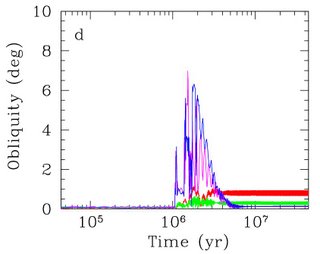Paper of the week

Evolution of the Obliquities of the Giant Planets in Encounters during Migration
Authors: Man Hoi Lee (UCSB), S. J. Peale (UCSB), Eric Pfahl (KITP), William R. Ward (SwRI)
Comments: 13 pages, including 2 figures; uses AASTeX; submitted to IcarusTsiganis et al. (2005) have proposed that the current orbital architecture of the outer solar system could have been established if it was initially compact and Jupiter and Saturn crossed the 2:1 orbital resonance by divergent migration. The crossing led to close encounters among the giant planets, but the orbital eccentricities and inclinations were damped to their current values by interactions with planetesimals. Brunini (2006) has presented widely publicized numerical results showing that the close encounters led to the current obliquities of the giant planets. We present a simple analytic argument which shows that the change in the spin direction of a planet relative to an inertial frame during an encounter between the planets is very small and that the change in the obliquity (which is measured from the orbit normal) is due to the change in the orbital inclination. Since the inclinations are damped by planetesimal interactions on timescales much shorter than the timescales on which the spins precess due to the torques from the Sun, especially for Uranus and Neptune, the obliquities should return to small values if they are small before the encounters. We have performed simulations using the symplectic integrator SyMBA, modified to include spin evolution due to the torques from the Sun and mutual planetary interactions. Our numerical results are consistent with the analytic argument for no significant remnant obliquities.
Letter
Nature 443, 1013 (26 October 2006) | doi:10.1038/nature05298Retraction: Origin of the obliquities of the giant planets in mutual interactions in the early Solar System
Adrián Brunini
When a new, independent code is used for the calculations on which the conclusions of this Letter were based, the results reported for the evolution of obliquity cannot be reproduced. This code was written in the inertial frame and is more reliable than the one used in the Letter. In most runs, the obliquities can change by only a few degrees and attain large values in only a very few cases. In addition, the obliquity variation shown in the Supplementary Information, although correct, originates from changes in the orbital inclination of the planet, and close encounters are not effective in causing large obliquities.
This was a strange episode. I can't recall another case in my field in which a paper in Nature or Science was retracted, not because of malfeasance, but just because the calculations were completely wrong. I feel bad for Brunini.

1 Comments:
But, of course, Brunini did the right thing by retracting the original result.
JoSe'L
Post a Comment
<< Home